Dictionary of Vexillology: M (Middle Arms – Mizzen) (original) (raw)
MIDDLE ARMS
See under ‘arms’.

Middle Arms of Bremen, Germany
MILITARY BANNER
See ‘banner 6)’ (also ‘sovereign’s banner’).
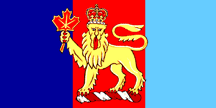
Commander in Chief banner, Canada
MILITARY COLOURS (or COLORS)
See ‘colour 2)’ and ‘colours 2)’.


Regimental Colour and Queen's colour, 1st Battalion of The Black Watch (Graham Bartram)
MILITARY CREST
In largely US usage, the term for that emblem which is displayed by units of the National Guard, and usually taken from symbols contained within the flags, seals and/or coats of arms of the relevant state – a state military crest (see also ‘badge 3)’, ‘coat of arms’, ‘crest 1)’, ‘emblem, military and governmental/departmental’, ‘seal’ and ‘state flag 2)’ and ‘wreath 2)’).
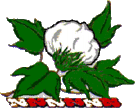


Military Crests of Alabama, Texas and Mississippi, US
MILITARY EMBLEM
See ‘emblem, military and governmental/departmental’ under ‘emblem’.
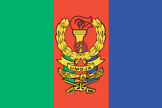
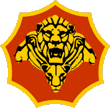
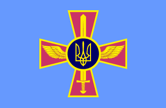
Flag/Emblem, People's Defence Force, Tanzania;Army Badge, RSA; Flag/Emblem, Air Force, Ukraine
MILITARY FLAGS
The general heading under which all the various flags, banners, pennants and colours relating to the military establishment of any particular country, countries or entity are listed – see ‘colour 2)’.
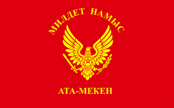

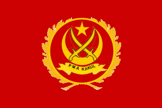
Armed Forces flag, Kyrgyzstan;Army Flag, UK; Flag of the Military Academy, Pakistan
MILLRIND (MILLRINE, MILL-INK or MILL-IRONS)
The alternative heraldic terms for a charge usually (but not invariably) in the form of a curved or wavy X, and meant to represent a mill bearing – a fer de moline, millrine, mill-ink or mill-irons (see also ‘millstone’).

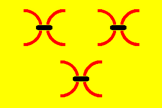

Flag of Göttingen County 1955–1973, Germany; Flag of Orthen, Netherlands; Flag of Borken County 1979–1984, Germany
MILLSTONE (or MILL-STONE)
The term for a representation of the large circular stone used for the grinding of wheat or other cereal by water- or windmill, and usually (but not invariably) shown with a square or notched hole in its centre and sometimes radiating ridges – a mill-stone, grind-wheel, grindwheel or grindstone – see ‘waterwheel’ (also ‘millrind’ and ‘windmill’).

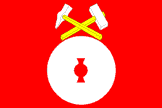

Flag of Sazes do Lorvão, Portugal; Flag of Choltice, Czechia; Flag of Rebolosa, Portugal
MILLWHEEL (or MILL-WHEEL)
See ‘waterwheel’.

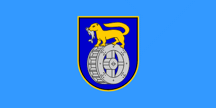
Arms and Flag of Veliki Grđevac, Croatia
MIRROR IMAGE
The term used when the reverse of a flag is a reflected duplication of the obverse (as seen as in a mirror), and the default assumption in most cases – but see ‘double-sided 1)’ and ‘two-sided 1)’ (also ‘obverse’ and ‘reverse’).


Obverse and Reverse of the Civil Ensign of Fiji
MITRE
In some Christian usage the ceremonial head covering of a prelate (see also ‘crozier’ and ‘stringed’).
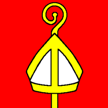


Flag of Bennau, Switzerland; Flag Bützow, Germany; Flag of La Rippe, Switzerland
MIXED TINCTURES
In heraldry there are two mixed tinctures, they are brunatre (brown) and tenne (orange) – auxiliary colours – see ‘tinctures’.
MIZZEN (or MIZZEN MAST)
The aftermost mast in a sailing vessel with three masts (and on a two masted vessel dependent upon the rig) from which the gaff is rigged – but see mizzen, at the (see also foremast, gaff, mainmast, mast and masthead).
MIZZEN, AT THE
(adv) The phrase used when a flag is flown from the ruck of the aftermost mast of a three masted sailing warship – see "mizzen" (above) (also masthead and truck).
[ ![[at the fore example]](http://www.crwflags.com/fotw/images/v/vxt-d3595.gif) ](../images/v/vxt-d3595.gif)
](../images/v/vxt-d3595.gif)
Flag of a Rear-Admiral 1864–1898, UK
Please note that in the sailing/steam-assisted navy, the command flag of a rear-admiral was formerly flown in this position (also balls of difference, flag of command and flagship)

